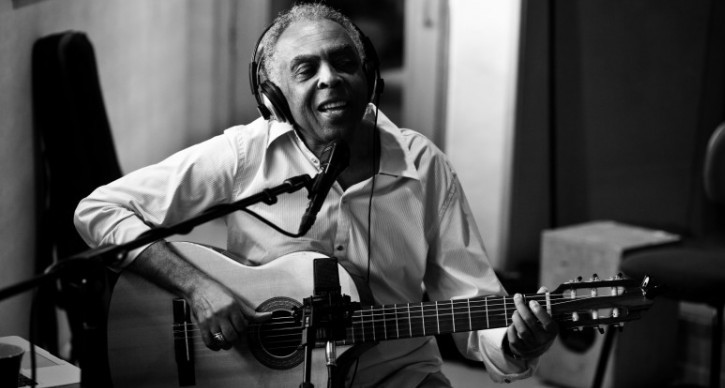A Taste of Tropicália
 Photo: Brazilian star Gilberto Gil performs at Hill Auditorium on April 4, 2015 at Hill Auditorium. Photo by Jorge Bispo.
Photo: Brazilian star Gilberto Gil performs at Hill Auditorium on April 4, 2015 at Hill Auditorium. Photo by Jorge Bispo.
The Brazilian Tropicália movement in the late 1960s is perhaps one of the greatest examples of music’s ability to be a powerful purveyor of change. The music created during this short time was a combination of Brazilian and international popular music; there were “mash-ups” of influences as varied as the Beatles or Jimi Hendrix and rhythmic Brazilian dance music like bossa novas or sambas. Many Brazilians saw this new music genre as “an adulteration of Brazil’s musical birthright by an American aesthetic.”
During this experimental, avant-garde period of musical expression, a military dictatorship loomed, ever present. Within a year, the leaders of the movement were imprisoned and then exiled, but they were not silenced, and others stayed and continued to perform their music. Over the course of the movement, the Tropicalistas began to inspire a generation with their exhilarating music as well as their indestructible spirit.
To offer a small taste of the power of the music created during this brief time, we have chosen some songs performed by four of the main players in the movement: Gilberto Gil, Caetano Veloso, Gal Costa, and Maria Bethania. Take a listen below!
Gilberto Gil is one of the most talented and prolific of the singer-songwriters to come from Tropicália. He has broached a wide variety of issues in his work; for example, he speaks often about social inequality and the conflict between science and religion. The song “Domingo no Parque” is one of Gil’s most popular songs. It was written in 1968 for his Gilberto Gil (Frevo Rasgado) album. The album is typical of Tropicália in its blending of traditional Brazilian styles with American rock and roll, while also mixing Rogério Duprat’s orchestral arrangements with Os Mutantes (mentioned below). Rolling Stone voted the track “Domingo no Parque” as one of Brazil’s greatest songs. Here it is!
Gilberto Gil performed at Hill Auditorium in 2012 and will return for another performance on April 4, 2015.
Caetano Veloso is another well-known singer and composer from that time period. In his 1968 debut album Caetano Veloso, he included a song titled “Tropicália.” The song got the name because of similarities between its content and that of Hélio Oiticica’s installation art piece. In fact, the song was entirely written before that name was assigned to it, and that name was never even meant to be a permanent title for the piece. The name caught on though, and soon it became a label for the entire movement of Tropicália.
Gal Costa is a female vocalist from the time period, and she worked quite frequently with the the other artists listed here. Her eponymous solo debut album in 1969 was hailed a Tropicália classic and was highly influenced by American psychedelic music. “Baby” was written by Caetano Veloso and performed by Costa. She speaks about how English should be learned in Brazil and mentions several pop references as well. A common trait of Tropicália music is that it mixes popular and traditional culture.
Rita Lee, Arnaldo Baptista and Sérgio Dias formed Os Mutantes, a popular Brazilian psychedelic rock band that became linked to Tropicália. The band reunited with different members in 2006, and has been touring and recording new material. Os Mutantes, the album released in 1968, includes compositions by both Caetano Veloso and Gilberto Gil. Gal Costa has also sung on several of their albums.
Even a brief overview of Tropicália shows that this late 1960s brief period of innovation and excitement has remained popular and produced a huge, lasting change in the Brazilian music scene. Teamwork and collaboration were key during this movement, and it was a time to point out flaws in Brazilian culture while working to create a positive change. The movement also provided inspiration to other artists around the world, such as David Byrne and Paul Simon, and many songs have been written in reaction to Tropicália. Artists active during Tropicália have continued to create music even when they have moved away from the original purposes of the movement, and they and their music have become an ever present part of Brazilian culture.
UMS is excited to bring a taste of one of Tropicália’s iconic members to Ann Arbor on April 4, 2015 at 8 pm in Hill Auditorium. We hope that you will come join us in hearing the astoundingly charismatic and influential music of Gilberto Gil.
Sources:
- Cahill, G. (2011, Jun). Tropicalia thunder. Pacific Sun. Retrieved April 8, 2014, from http://search.proquest.com.proxy.lib.umich.edu/docview/874154508?accountid=14667
- Os Mutantes. (n.d.). NPR. Retrieved April 8, 2014, from http://www.npr.org/artists/17080024/os-mutantes
- The Best Tropicalia Albums: Sounds and Colours. (n.d.).The Best Tropicalia Albums: Sounds and Colours. Retrieved April 8, 2014, from http://www.soundsandcolours.com/guides/the-best-tropicalia-albums/
- Tropicalia. (n.d.). PBS. Retrieved April 7, 2014, from http://www.pbs.org/wgbh/cultureshock/flashpoints/music/tropicalia.html







